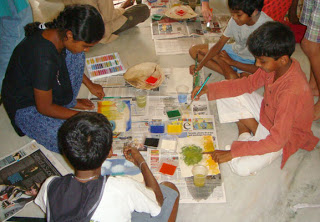A Day with Kabir at Shibumi

The day started unusually for me – with zero expectations. Shabnam and I were on our way to ‘Shibumi’ – a non-formal school conducted in a house on the outskirts of Bangalore city. About 35 children,and 7-8 dedicated teachers – who were themselves exploring boundaries of learning with stories, arts, songs, and lots of play. I looked forward to this day – a day of singing and sharing Kabir, with a vertical age group from 6 to 60, as playmates.
The singing began in a long open room – well lit, with walls of books, drawings, odds and ends. The little ones sat closest to us, clustered around – wide, bright eyes, open mouths, a wonder in their looks as they watched Shabnam sing with her head thrown back, eyes closed, a smile – expressing a little of the world she inhabited inside. The older, taller ones sat systematically further – yet all eyes were in focus, all bodies still. I watched this audience, that we were priviledged to have, in perfect oneness with Shabnam, her Kabir songs.
From the little ones, we got most attention with songs containing imageries of the external world – ants with anklets, roaming huge elephants, proud kings. They got restless with inner probings and were comfortable enough to lie down, or walk away -peek from the windows when curious. There was an ease, a ‘sahajata’ in this behaviour, that only children growing up in such open systems are able to retain and express.
The older ones were ‘stayed’ with us longer, with a deeper involvement with a questioning Kabir, shy, but responding to questions, in conversation, in Satsang.
This whole audience absolutely lit up when it was time to sing ‘ Mat Kar Maya Ko Ahamkar…’ – it was a song they had learnt with Nilanjana over many prior sessions – and now they sang it with energy, gusto, huge smiles – all sang!Our last session culminated with a story and song – the brave parrot song ‘ He Mari Heli re – Kin sa karan main prem?’Hugely popular with young and old alike – this is a song about the courage and compassion of a little parrot that would not abandon its tree during a forest fire.
The children then broke into several groups to pictorially represent this story in four segments to produce canvas scrolls, while one group decided to do a theatrical interpretation of the story’s essence.
 Read the entire article here.
Read the entire article here.
Note: If you are receiving this blog post in an email or through an RSS feed and cannot see the video, please open the link in a new page








